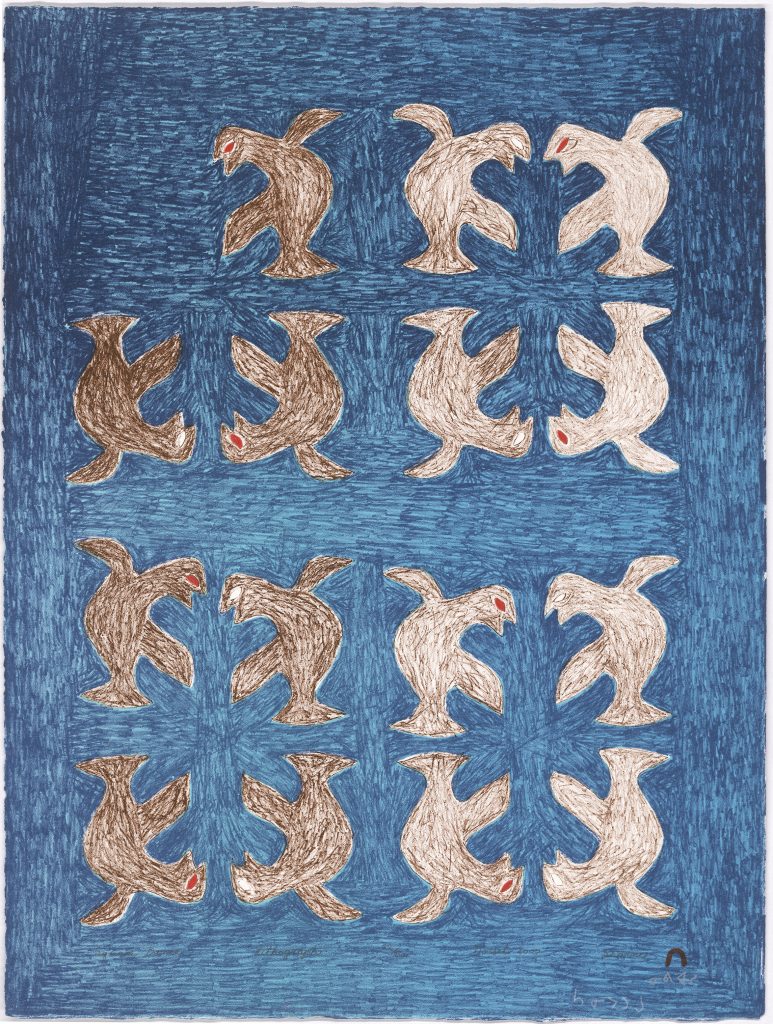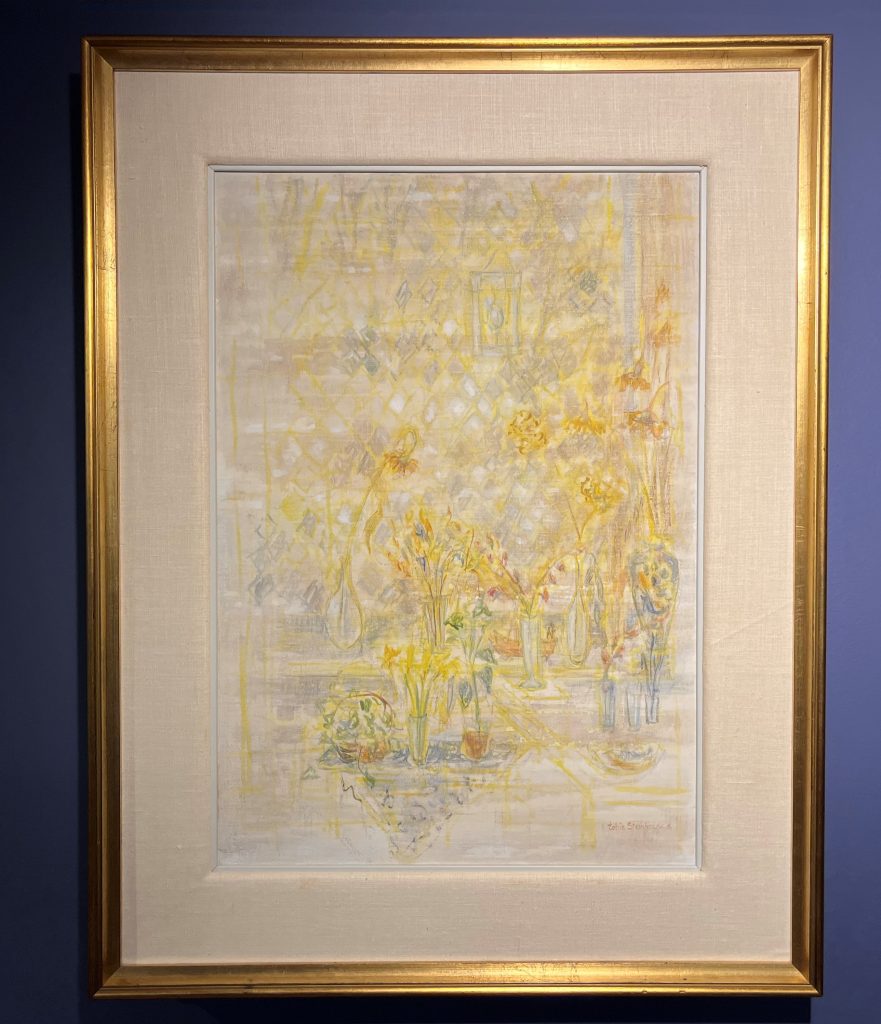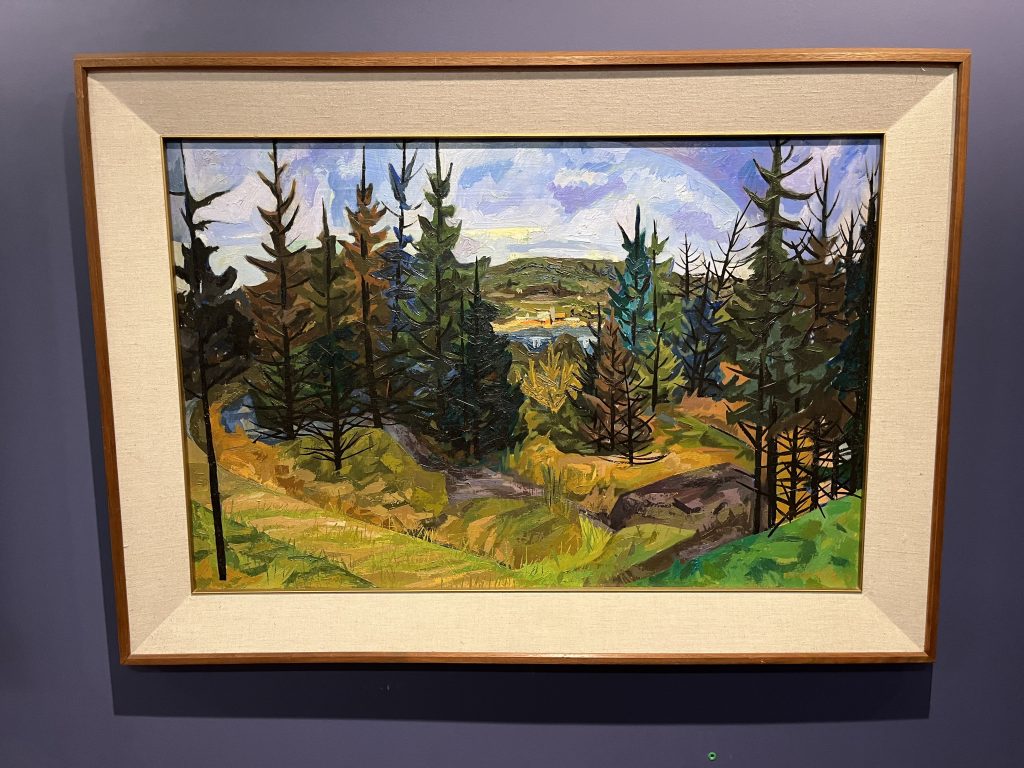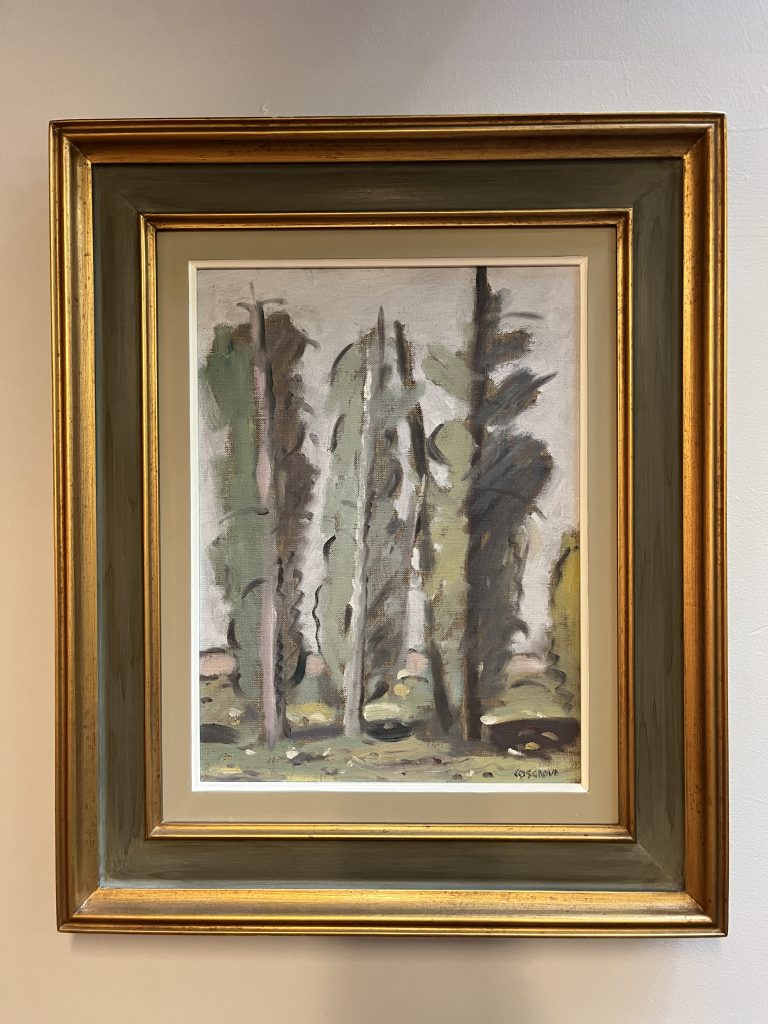By McGill Visual Arts Collection
Recently the Visual Arts Collection added a few new artwork to our Visible Storage Gallery on the 4th Floor of the McLennan Library. Let us introduce you to these artworks!
Sharni Pootoogook, Square Dance, 2000, Lithograph. Gift of Jamie Cameron LL.B., 1978 and Christopher Bredt.
Sharni Pootoogook (1922-2003) was an Inuk artist from Kinngait (Cape Dorset) and is a member of the Ashoona-Pootoogook family, who have made significant contributions to the arts across four generations. A multi-disciplinary artist, Pootoogook created prints as well as carvings. Today, her prints are collected by major museums and are characterized by their whimsical approach. Her work centres around groups of animals–her most frequent subjects being flocks of birds.
Heather Igloliorte, an Inuk art historian and professor at Concordia, discusses the concept of Inuit Qaujimajatuqangit in relation to artworks.1 Though it is often translated as “Inuit traditional knowledge” this is an oversimplification. It can be more accurately understood to encompass the complex matrix of Inuit environmental knowledge, societal values, cosmology, worldviews, and language. Sharni Pootoogook’s Square Dance incorporates this concept because of its depiction of seals, an animal that is commonly hunted for food and other goods. Hunting animals in the arctic requires environmental knowledge, which would be considered Inuit Qaujimajatuqangit. Perhaps, the missing seal in the corner is a comment on the threatened status of seals in the arctic. Due to climate change and over hunting by non-Inuit hunters, the seal at top left is missing its dance partner.
This work is one of eight pieces at the Visual Arts Collection that were created by a member of the Ashoona-Pootoogook family. The VAC cares for pieces by Sharni’s husband, brother-in-law, and Pitseolak Ashoona, the matriarch of the family and mother of contemporary Inuit art. Many of the works by this family can be seen on the first floor of Chancellor Day Hall.
Eldred Allen, Skull of Harps, 2018, Photograph, 42.5 x 72 cm. Gift of Richard Budgell.
Skull of Harps by Eldred Allen (1978-) is an aerial photograph of seals swimming in a group. Allen’s artistic practice is taken directly from the surrounding land and waters of his home in Rigolet, Nunatsiavut, Newfoundland. The Inuk photographer’s body of work also gives back. His images, captured with handheld cameras and drones, have been used by scientists studying ocean life and climate change, and Google Maps have relied on his images of Labrador’s coastal region. Allen’s masterfully composed images have also made waves in the art world. His prints were recently exhibited at Montreal’s La Guilde and he is represented by the Stephen Bulger Gallery in Toronto.
The McGill Visual Arts Collection is thrilled to exhibit this artwork in the Visible Storage Gallery thanks to the generous donation of Dr. Richard Budgell. Skull of Harps is an excellent example of how wonderfully complex photography is. Since their very beginning, photographs have changed how we see. Here, the streamlined bodies of the seals ripple through the cold blue waters of the Labrador Sea. In the upper left corner of the composition we see a seagull soaring and notice it’s shadow on the surface of the water. This confirms to the viewer we have a bird’s eye vantage point. If we are above the water, however, why do we see the spotted bellies of the seals? Are we looking up at them from under the water? This disorientation is a photographic experience. Allen’s framing allows us to marvel at the wonders of the natural world – and has taught us here at the VAC that harp seals swim upside-down to sun their bellies to keep warm and look for fish below. Thank you Eldred Allen for reminding us how beautifully topsy-turvy this world is!
Tobie Steinhouse, Sans titre, 1986, Oil on canvas, 51 x 35.5 cm. Gift of Lise Théroux.
Tobie Thelma Steinhouse (1925-) is a printmaker and painter. As a high school student at Baron-Byng High School she studied art with influential artist and educator, Anne Savage. These early experiences with Savage, who was a strong supporter of women in the arts, informed her career path as she attended Sir George Williams (Concordia University) in Engineering Drawing. Upon graduation, she worked for the Royal Canadian Air Force drawing manuals and warplane designs in the 1940s. After the war, she moved away from the applied arts to develop her own expressive style. First, she studied at the Arts Students League in New York and then the École des beaux-arts de Paris. Throughout this time, Steinhouse’s art was exhibited in various art galleries. She later worked at Atelier 17 under Stanley Hayter in Paris. Here, Steinhouse expanded her printmaking practice with experimentation and bold colour combinations in the intaglio process.
While Steinhouse became best known for her distinctive abstract full plate prints, the VAC is delighted to welcome this more airy, impressionist gift from Lise Théroux into the collection. Sans titre is cheerful yellow still life of plants and sunlight beaming through a window pane. The artist would return to this window in her studio over and over again throughout her œuvre. An artist’s studio – particularly that of a woman artist – is typically a space that is carved out of the domestic sphere. Steinhouse’s window offers us a view into her own artistic realm.
Alfred Pinsky, Untitled, 1959, Oil on Canvas. Gift of Naomi Lapin B.A. ’68 BCL ’71 BSW ’89 MSW ’90 and Jeffrey Rother in loving memory of Pearl and Murray Lapin B.A. ’40 MA ’41 BCL ’44.
Alfred Pinsky (1921-2000) was a Canadian artist and educator. He is perhaps best known for his involvement in the Jewish Painters of Montreal, who depicted social realism in their work throughout the 30s and 40s. This collective mostly consisted of new immigrants from Eastern Europe with strong religious and political ideas. For reference, Pinsky’s father was an American communist. The VAC currently cares for eight pieces by Ghitta Caiserman-Roth, Pinsky’s first wife who was also an art education and active in the Jewish Painters of Montreal group.
In 1959, Pinsky began teaching studio classes at Sir George Williams University. By 1962, he served as the Department of Fine Arts first chairman. Pinsky even encouraged other notable artists like Yves Gaucher to join the department. Yves Gaucher’s prints Inversion I and II are also on display at McGill’s Visible Storage Gallery on McLennan’s fourth floor. Though they were acquaintances, Pinsky’s picturesque landscapes differ greatly from Gaucher’s minimal, modernist prints. Pinsky took a completely different approach, going for more figurative, but still abstract pieces. In this untitled landscape, for instance, the artist creates a composition that is inspired by but breaks away from the hyper-realism so characteristic of early 20th century Quebec art. It is unclear what region is represented, but Pinsky often painted in the Laurentians and other mountainous and forest regions in Quebec.
In 1974, when Sir George Williams University merged with Loyola College to become Concordia University, Pinsky became Concordia’s first Dean of the Faculty of Fine Arts. Around this time, Pinsky convinced the administration to create Quebec’s first graduate program in art education. To commemorate Pinsky, Concordia now awards the Alfred Pinsky Medal to the highest-ranking student graduating with a Bachelor of Fine Arts every year.
Nancy Petry, Bird of Paradise, 1952, Oil on canvas, 59.5 x 85 cm. Gift of the Artist.
The warm, earthen tones of Bird of Paradise (1952) by Montreal artist Nancy Petry is an intimate portrait of a reclining woman. Petry is a graduate of the University’s short-lived Bachelor of Fine Arts program in the late 1940s. Building upon her artistic training at McGill and her travels in Europe, Petry’s practice evolved; in the 1960s, she became one of the first Canadian artists to paint lyrical abstractions. Her wide-ranging interests lead her to become a printmaker and to participate in happenings, art interventions, and new media in the 1970s. Petry was inducted into the Royal Canadian Art Academy in 2015.
In this early work, she uses angular shapes, undisguised brushstrokes, and thick outlines to define her peaceful subject. Head in a soft sage pillow and wrapped in a green blanket, the figure lies in front of a tall bird of paradise plant. The large leaves of this tropical plant extend from a terracotta pot in the background and the distinctive crane-like bloom is just out of Petry’s frame.
Bird of paradise leaves have evolved to split at the seams so high tropical winds can blow through them, helping the stalk to grow tall. This natural wonder and Petry’s portrait of a resting woman are good reminders that letting go and taking a break can be forms of strength too.
Stanley Cosgrove, Trees, Laurentian, 1978, Oil on Masonite, 59 x 48.5 cm. Gift of Mrs. Rose Bidler.
Stanley Cosgrove (1911-2002) was a Canadian artist that relished in the formal qualities of forested landscapes. He once remarked, “They’re not trees. They’re not trees at all. They’re just perpendiculars and horizontals. That’s what they are to me. Why do I repeat them? Repetition is what painting is all about, repetition of themes, repetition of subject matter. Paint. That’s all a painter wants to do.”2 The last post in this series about the new artworks in the Visible Storage Gallery of McLennan Library is about Cosgrove’s beloved trees. The painting, which depicts slender trees neatly arranged in a pastel palette of soft sage greens, blues, and blushes is indicative of the artist’s restrained, late modernist style.
Cosgrove was trained at Montreal’s École des beaux-arts in the 1930s. After this, he studied at the Art Association of Montreal under Edwin Holgate. The VAC is especially pleased to display Cosgrove’s painting near another painting by Holgate. This proximity encourages our appreciation for art education. It serves as an homage to the impact educators have on students and demonstrates the beautiful results that can come from inspiring educators.
After traveling to Mexico to study mural painting with José Clemente Orozco from 1941 to 1944, he returned to teach at the École in Montreal in the late 1950s. His work was exhibited widely and is now found in major institutional collections.
- Heather Igloliorte, “Inuit Art: Markers of Cultural Resilience.” Inuit Art Quarterly 25, no. 1 & 2 (Spring/Summer 2010): 7.
2. “Stanley Cosgrove,” Klinkhoff Gallery. https://www.klinkhoff.ca/artists/100-stanley-m.-cosgrove%2C-r.c.a./


















Leave a Reply
You must be logged in to post a comment.